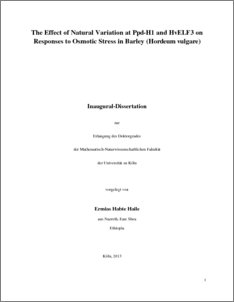Haile, Ermias Habte
(2013).
The Effect of Natural Variation at Ppd-H1 and HvELF3 on Responses to Osmotic Stress in Barley (Hordeum Vulgare).
PhD thesis, Universität zu Köln.

![[img]](https://kups.ub.uni-koeln.de/style/images/fileicons/application_pdf.png)  Preview |
|
PDF
Ermias_Haile_Thesis.pdf
- Published Version
Download (2MB)
|
Abstract
The circadian clock is an important timing system that, in part, controls stress adaptation in Arabidopsis thaliana. In the model crop barley, the clock orthologs Ppd-H1 and HvELF3 are important regulators of photoperiod response and flowering. However, little is known about additional effects of the clock on plant performance and stress adaptation in barley. Therefore, the objectives of this study were i) to analyse the effects of natural variation at the barley photoperiod response and clock genes Ppd-H1 and HvELF3 on response to osmotic stress and ii) to test whether osmotic stress at the root acted as an input signal to the shoot circadian clock and thus changed diurnal patterns of physiological traits.
The first chapter describes changes in gene expression and physiology under polyethylene glycol induced osmotic stress in seedlings of two spring barley cultivars carrying a natural mutation in Ppd-H1 and two derived introgression lines with the wild type Ppd-H1 allele. Analysis of performance at three consecutive days under stress revealed that the natural mutation in Ppd-H1 resulted in reduced cell membrane injury and increased photosynthetic activity and concomitant lower expression of stress-responsive and senescence-activated genes as compared to the introgression lines with the wild type Ppd-H1 allele. In the second chapter, I analysed diurnal changes of clock and stress -expression and of leaf water relations and gas exchange in two pairs of genotypes varying at Ppd-H1 and HvELF3. Variation at HvELF3 affected the phase and shape of the clock and stress-gene expression profiles, whereas variation at Ppd-H1 modified the expression levels only of stress genes. Osmotic stress upregulated expression of clock and stress-response genes and advanced their expression peaks. Expression differences in clock genes did not have strong effect on the diurnal expression of physiological traits.
Taken together, this thesis demonstrates that osmotic stress at the barley root altered clock gene expression in the shoot and acted as a spatial input signal into the clock. Ppd-H1 controlled stress-induced senescence, while variation at HvELF3 did not affect senescence related traits, and had minor effects on gas exchange under stress. Unlike in Arabidopsis, barley primary assimilation was less controlled by the clock and more responsive to environmental perturbations, such as osmotic stress.
| Item Type: |
Thesis
(PhD thesis)
|
| Translated abstract: |
| Abstract | Language |
|---|
| Die circadiane Uhr ist ein interner Zeitmesser, der unter anderem die Anpassung an Stress in der Modelpflanze Arabidopsis thaliana koordiniert. In der Modell-Getreidepflanze Gerste spielen die Uhrgene Ppd-H1 und HvELF3 eine wichtige Rolle für die Regulierung der Blüte in Abhängigkeit der Photoperiode. Allerdings ist der Einfluss der circadianen Uhr auf die agronomische Leistung und Anpassung an Stress in Gerste noch wenig erforscht. Das Ziel dieser Arbeit ist es, i) den Einfluss natürlicher Variation an Ppd-H1 und HvELF3 auf das Verhalten von Gerstenkeimlingen unter osmotischen Stress zu untersuchen, ii) den Effect von osmotischem Stress an der Wurzel auf die Expression von Uhrgenen und physiologischer Merkmale im Blatt zu untersuchen.
Im ersten Teil meiner Arbeit beschreibe ich die Effekte von Variation an Ppd-H1 auf die Expression von Stress-induzierten Genen und physiologische Merkmale unter osmotischem Stress, induziert durch Polyethylenglycol. Zwei Genotypen mit verschiedenen Allelen für Ppd-H1 zeigten unter osmotischem Stress Unterschiede in der photosynthetischen Aktivität und Zellmembranpermeabilität, und in der Expression von Stress- und Seneszenz- induzierten Genen. Im zweiten Teil meiner Arbeit gehe ich näher auf die Interaktion von osmotischem Stress und diurnalen Änderungen circadianer Rhythmen ein. Hierfür wurden diurnale Genexpressionsprofile der Uhrgene und Stress-induzierter Gene erfasst, sowie Änderungen physiologischer Parameter unter osmotischem Stress untersucht. Osmotischer Stress führte zu einer Induktion von Genen der circadianen Uhr und der Stress-Signalwege, sowie zu einer Verschiebung ihrer diurnalen Expressionsprofile. HvELF3 beinflusste die Expressionsphase und Form von Uhr- und Stressgenen, während Ppd-H1 nur die Expressionshöhe von Stressgenen regulierte. Diese Veränderungen korrelierten nicht mit Änderungen in den betrachteten physiologischen Parametern.
Zusammenfassend zeigen meine Ergebnisse, dass Ppd-H1 neben seiner Rolle in der photoperiodischen Regulation der Blüte pleiotrope Funktionen in der osmotischen Stressantwort und der Stress-induzierten Seneszenz übernimmt. Des Weiteren führte osmotischer Stress an den Wurzeln zur Änderung der Genexpresssion der circadianen Uhr im Spross. Im Unterschied zu Arabidopsis scheint der Primärmetabolismus in Gerste weniger stark von der circadianen Uhr als von äusseren Umwelteinflüssen, wie osmotischer Stress, kontrolliert zu sein. | German |
|
| Creators: |
| Creators | Email | ORCID | ORCID Put Code |
|---|
| Haile, Ermias Habte | ermiayshab@yahoo.com | UNSPECIFIED | UNSPECIFIED |
|
| URN: |
urn:nbn:de:hbz:38-53340 |
| Date: |
25 August 2013 |
| Language: |
English |
| Faculty: |
Faculty of Mathematics and Natural Sciences |
| Divisions: |
Faculty of Mathematics and Natural Sciences > Department of Biology > Institute for Genetics |
| Subjects: |
Natural sciences and mathematics |
| Uncontrolled Keywords: |
| Keywords | Language |
|---|
| Barley, Osmotic stress,Circadian clock,Stress-responsive gene,ABA,Physiological performance. | UNSPECIFIED |
|
| Date of oral exam: |
14 October 2013 |
| Referee: |
| Name | Academic Title |
|---|
| Couplanad, George | Prof. Dr. | | Höcker, Ute | Prof. Dr. |
|
| Refereed: |
Yes |
| URI: |
http://kups.ub.uni-koeln.de/id/eprint/5334 |
Downloads per month over past year
Export
Actions (login required)
 |
View Item |


